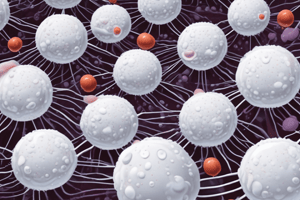Podcast
Questions and Answers
What are leukocytes more commonly known as?
What are leukocytes more commonly known as?
- Red blood cells
- Platelets
- Stem cells
- White blood cells (correct)
What is the primary function of leukocytes?
What is the primary function of leukocytes?
To combat infections and foreign substances.
Match the types of leukocytes with their descriptions:
Match the types of leukocytes with their descriptions:
Neutrophils = Most common leukocyte; active phagocytes. Eosinophils = Involved in allergic reactions and parasitic infections. Basophils = Least common leukocyte; mediate inflammation. Lymphocytes = Include B cells and T cells; involved in adaptive immunity.
What are granulocytes characterized by?
What are granulocytes characterized by?
What do neutrophils primarily do?
What do neutrophils primarily do?
Basophils are the most common type of leukocyte.
Basophils are the most common type of leukocyte.
What triggers neutrophils to migrate to damaged tissue?
What triggers neutrophils to migrate to damaged tissue?
Which leukocytes are involved in producing antibodies?
Which leukocytes are involved in producing antibodies?
Where do T lymphocytes mature?
Where do T lymphocytes mature?
What is leukopoiesis?
What is leukopoiesis?
Flashcards are hidden until you start studying
Study Notes
Leukocytes (White Blood Cells)
- Larger than erythrocytes and contain a prominent nucleus.
- Utilize the bloodstream for transport but generally function outside of blood; they adhere to blood vessel walls to enter surrounding tissue.
Classification of Leukocytes
- Divided into two main categories:
- Granulocytes: Have cytoplasmic granules activated when needed.
- Agranulocytes: Lack visible granules but contain lysosomes.
Granulocytes
- Characterized by unusual nucleus shapes; single nucleus composed of 3-5 lobes.
- Contain general lysosomal granules and unique granules for each granulocyte type.
- Categories based on granule stain color: light lilac (neutrophils), dark purple (basophils), and red (eosinophils).
Neutrophils
- Most numerous leukocyte; stains light lilac due to granules.
- Active phagocytes that destroy bacteria.
- Known as polymorphonucleocytes (polys or PMNs); their unique nucleus aids in identification.
- Attracted to damaged tissue through chemotaxis, where they exit blood and release granules to kill bacteria and enhance inflammation.
Eosinophils
- Recognizable by bi-lobed nucleus and red staining.
- Function as phagocytes, responding primarily to parasitic infections and allergic reactions.
- Granules contain specific enzymes to combat parasites and mediate inflammation.
Basophils
- Least common leukocyte; has an S-shaped dark purple nucleus.
- Granules contain chemicals that mediate inflammation.
- Secretes:
- Histamine: An inflammatory chemical promoting vasodilation.
- Heparin: An anticoagulant preventing blood clotting.
Agranulocytes
- Include lymphocytes and monocytes, which do not have visible granules but have lysosomes.
Lymphocytes
- Second most common leukocyte; characterized by large, spherical nuclei and a narrow rim of cytoplasm.
- Two types: B lymphocytes and T lymphocytes, both activated by antigens.
B Lymphocytes (B Cells)
- Produce antibodies when activated, targeting specific antigens.
- Each B cell population secretes antibodies specific to unique antigens.
T Lymphocytes (T Cells)
- Activated by specific antigens but do not produce antibodies.
- Have receptor proteins on their membrane for unique antigens.
- Function to activate immune components and destroy abnormal cells, such as cancer or virally infected cells.
Monocytes
- Largest leukocyte with a U-shaped nucleus and light blue or purple cytoplasm.
- Exit blood to become macrophages in tissues, where they phagocytize dead cells, bacteria, and other debris.
Macrophages
- Phagocytic cells that clean up cellular debris and activate other immune system components by presenting phagocytized antigens.
Leukopoiesis
- The process in the bone marrow where hematopoietic stem cells (HSCs) differentiate into new leukocytes.
- HSCs produce two cell lines:
- Myeloid Cell Line: Produces most formed elements, including erythrocytes and platelets.
- Lymphoid Cell Line: Produces lymphoblasts, committed to becoming B and T lymphocytes.
Maturation of Lymphocytes
- B lymphocytes mature in the bone marrow.
- T lymphocytes migrate to the thymus gland in the mediastinum for maturation.
Studying That Suits You
Use AI to generate personalized quizzes and flashcards to suit your learning preferences.




